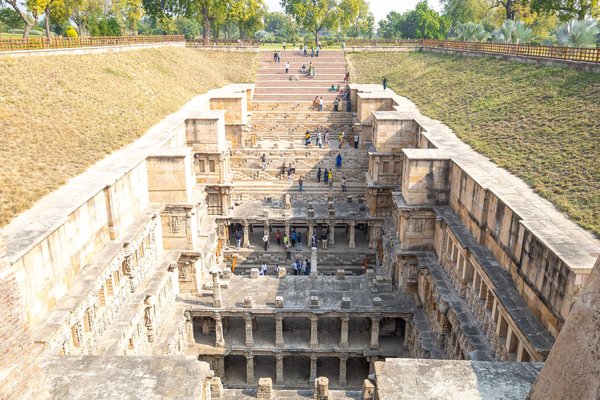India
Rani-ki-Vav
Rani-ki-Vav (The Queen's Stepwell) at Patan, Gujarat is the most developed and ornate example of this type of subterranean water architecture in India.
Stepwells are wells or ponds in which the water may be reached by descending a set of steps. These were sites for collecting water and socialising, but also simultaneously hold great spiritual significance. Rani-ki-Vav was built in the 11th century. It has more than 500 figurative sculptures with mostly religious and mythical themes, divided across seven galleries.
Community Perspective: “A fantastic, hidden gem”. Best visited on a combined day trip with the Sun Temple in Modhera by taxi from Ahmedabad.
Site Info
Official Information
- Full Name
- Rani-ki-Vav (The Queen's Stepwell) at Patan, Gujarat (ID: 922)
- Country
- India
- Status
-
Inscribed 2014
Site history
History of Rani-ki-Vav
- 2014: Inscribed
- Inscribed
- Type
- Cultural
- Criteria
- i
- iv
Links
- UNESCO
- whc.unesco.org
- Official
-
- asi.nic.in — Archaeological Survey of India
All Links
UNESCO.org
- whc.unesco.org — whc.unesco.org/
Official Website
- asi.nic.in — Archaeological Survey of India
News Article
- Feb. 28, 2015 thehindubusinessline.com — Patan's 11th century step-well chosen for restoration
- May 22, 2014 timesofindia.indiatimes.com — Gujarat's 'Rani ki Vav' to be digitally recreated
Community Information
- Community Category
- Archaeological site: South (East) Asian
Travel Information
Recent Connections
-
Translated Toponyms
A Vav is a stepwell in Gujarati. The fu… -
Foreigner prices
Rs 40 per Indian, Rs 600 per foreigner. -
Built in the 11th century
built as a memorial in the 11th century…
Connections of Rani-ki-Vav
- Trivia
-
-
On Banknotes
On new Rs 100 note (2018) -
Subterranean Cultural Sites
"a unique type of Indian subterranean architectural structure" (AB ev) -
Dubbed as another WHS
Taj of Stepwells (Book India: UNESCO World Heritage Sites, August 2021) -> after the Taj Mahal
-
- Architecture
-
-
Octagons
"All pillars in Rani-ki-Vav are uniform in design with square shaped plinths and carved niches housing deities on opposite sides. The octagonal drums are divided into four vertical, decorative segments and the capitals are designed in the form of quadruple brackets, the undersides of which carry four human or animal heads." (AB ev)
-
- Damaged
-
-
Destroyed or damaged by Earthquake
"The fact that the top storeys of the pavilions have been lost – likely in an earlier massive earthquake - leaves the side walls more vulnerable during earthquakes." (AB ev)
-
- World Heritage Process
-
-
Perfect Inscriptions
2014
-
- Religion and Belief
-
-
Vishnu cult
"The sculptures associated with Vishnu outnumber all other deities, and include Sheshashayi Vishnu (Vishnu reclining on the thousand-hooded snake Shesha in the celestial ocean), Vishwarupa Vishnu (Cosmic form of Vishnu) and the Dashavatara (ten incarnations) of Vishnu" (wiki)
-
- Human Activity
-
-
Man-made Terraces
"Attributes encompass the consecutive stepped terraces.." (AB ev)
-
- Constructions
- Timeline
-
-
Built in the 11th century
built as a memorial in the 11th century CE (Nom File)
-
- Visiting conditions
-
-
Foreigner prices
Rs 40 per Indian, Rs 600 per foreigner.
-
- WHS Names
-
-
Translated Toponyms
A Vav is a stepwell in Gujarati. The full site name includes the English translation.
-
News
- thehindubusinessline.com 02/28/2015
- Patan's 11th century step-well cho…
- timesofindia.indiatimes.com 05/22/2014
- Gujarat's 'Rani ki Vav' to be digi…
Recent Visitors
Visitors of Rani-ki-Vav
- Alberto Rodriguez Gutierrez
- A. Mehmet Haksever
- Atila Ege
- Bernard Joseph Esposo Guerrero
- Bill Maurmann
- Bin
- Carlo Sarion
- Chinmaya
- CynthiaSam
- David Marton
- DouglasR
- Els Slots
- GerhardM
- Iain Jackson
- Ivan Rucek
- Jana and Matt
- Joel on the Road
- Kurt Lauer
- lichia
- Loic Pedras
- Luis Filipe Gaspar
- Lukasz Palczewski
- Luke LOU
- marcel staron
- Martina Rúčková
- MaYumin
- Mikko
- Miloš Tašković
- Morodhi
- Philipp Peterer
- Priyaranjan Mohapatra
- Ralf Regele
- Randi Thomsen
- Roman Bruehwiler
- Sergio Arjona
- Shandos Cleaver
- Solivagant
- Stanislaw Warwas
- Svein Elias
- Szucs Tamas
- Taotao Chen
- Thomas van der Walt
- Tim Allen
- Velvetlapis
- Vincent Cheung
- Wojciech Fedoruk
- Xiquinho Silva
- Zoë Sheng
Community Reviews
Show full reviews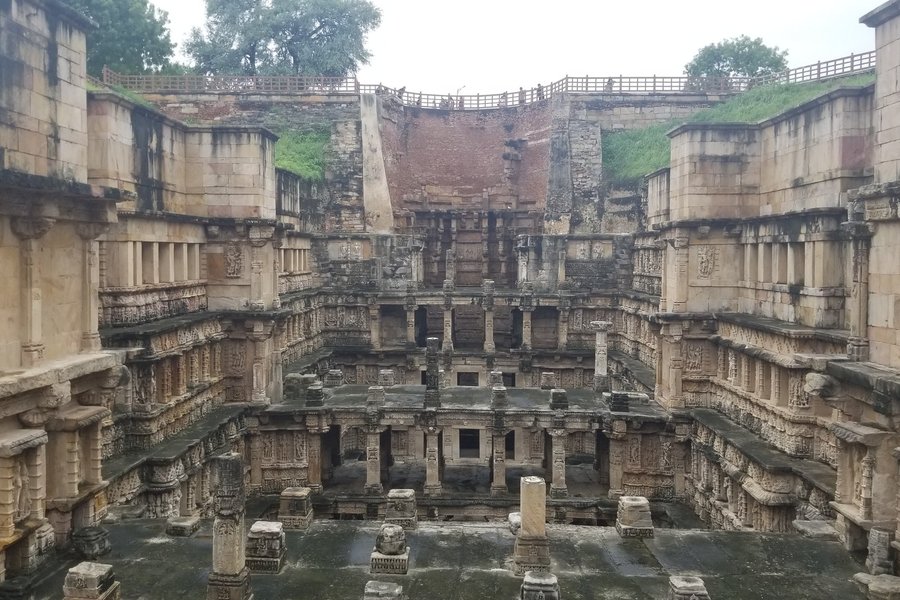
Rani-ki-vav (The Queen's Stepwell) is one of the best places in India to visit. It's not big but the small amounts you see are "massive" and will stay in your head for a long time. Most people would just do this as a daytrip from Ahmedabad as it's only 2h away but seeing that there are other enjoyable things in Gujarat I added it to my trip overall.
First off you MUST buy your ticket online which is rather annoying for us foreigners. I didn't have a local SIM card for the 3 days in India and my driver already went to lunch so he couldn't give me a hotspot. Luckily the security guard gave me a hotspot. I was then worried that foreign credit cards wouldn't be possible to purchase the ticket (which is often the case for Indian security on the websites) but that wasn't an issue. So I got the ticket and could enter. There was a whole rush of people trying to navigate this online purchase but I managed to finish off within 3 minutes.
After ending up inside it's only a short walk to the actual site. The park itself itself is nice but what's worthy to come here. I'll say it now that I did walk around the entire area, which includes a toilet, but mainly because my driver was still out for a while and the temple doesn't take long to see either. In fact most of the time spent here was taking …
Keep reading 0 comments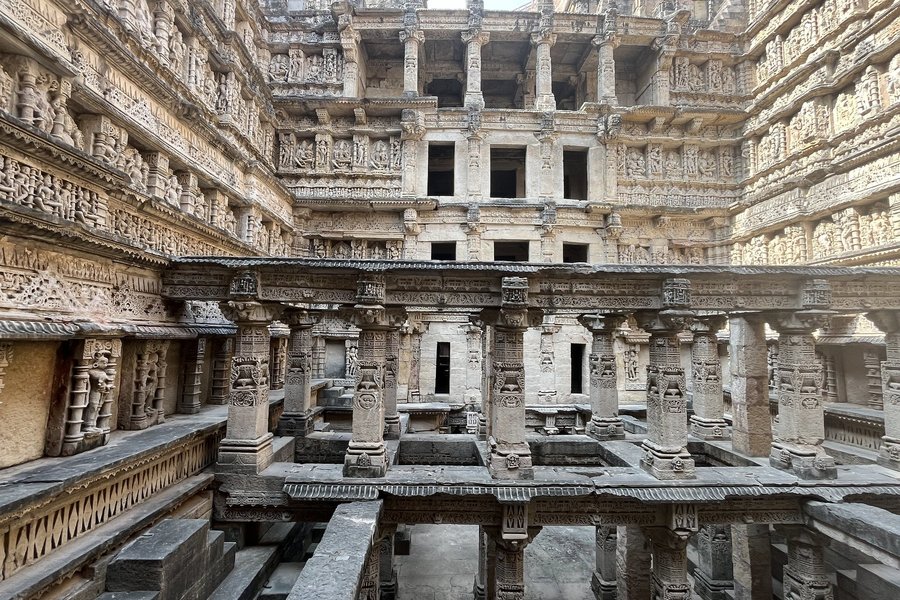
We visited this wonderful place in 2009 and we were really overwhelmed when entering, which means going downstairs. It is a really impressing site in Gujarat, where you can discover such a lot of beautiful places.
Stepwells are a very special form of subterranean water resource and storage systems on the Indian subcontinent, and have been constructed since the 3rd millennium BC. Till now I have not heared from stepwells in other countrys.
It is a spectacular building with a long and rich history, a long way off the beaten tourist tracks. We visited this place on a 8 day journey through Gujarat whith a driver from Ahmedabad and visited it, like al lot of other people together with the sun temple of Modhera, also an interesting and really worthy place.
The fact it was buried for centuries and only recently excavated tells a fascinationg story. It was our first stepwell we have ever seen and we I like the general architecture.
Keep reading 0 comments
This is a fantastic, hidden gem of India. Stepwells are large, flat wells that were once quite common in this part of India, and the Queen's Stepwell here is one of the largest and most ornate. It's surprisingly large in area: about 60x20 metres in area, and 27 metres deep. On the inside, every inch of the walls is covered in carving, mostly of Hindu gods but there are some secular figures in there as well. The carvings are extremely beautiful and in fantastic condition as well, as the site was completely silted over until its discovery in the 1980s. The surrounding area is well manicured as well, though there isn't anything to see at the site other than the stepwell, which unless you're super into photography, probably won't take longer than an hour to thoroughly inspect.
We accessed the site via a private car from Ahmedabad. It's about 2.5 hours each way, and we ended up paying about 3500 rupees to hire the driver for the day.
Overall this is a strongly recommended site. It's definitely a bit out of the way, but a trip that we definitely found worthwhile. It's a site unlike any other we've visited so far!
Keep reading 0 comments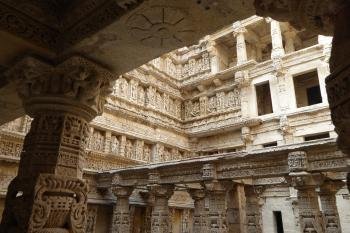
This is a really nice site - a spectacular building with a rich history, off the beaten tourist tracks but well-developed for a visit. The fact it was buried for centuries and only recently excavated only adds to the charm. I like the general architecture of stepwells, but this one comes jam-packed with rich stone carvings. I rented a driver for a day from Ahmadabad and visited the site together with Modhera (also very worthy). The site itself is fenced in and guarded - which means it is clean and free of touts. It's not too big - there are no further buildings apart from the stepwell. A bit of climbing is required to reach the bottom of it. Compared to the Ahmadabad stepwells, the Rani-ki-Vav is much more decorated, but also a bit more damaged. I would recommand to visit the adalaj stepwell first to get an impression of the general stepwell layout, and than the Rani-ki-Vav for sheer beauty.
All-in-all, I think this site needs a bit more love - it certainly deserves better than scrape around the bottom of our top lists !
Visited: Nov 2015
Importance: 3/5 Beauty: 5/5 Uniqueness: 5/5 Environment: 3/5 Experience: 5/5
Keep reading 0 comments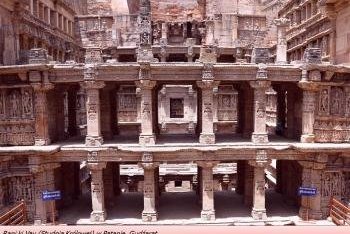
Visited in May 2015.
Rani-ki Vav is one of the biggest and most ornamented stepwells you can find in Gujarat and southern Rajastan. It was constructed at the beginning of the rule of Solanki dynasty (XI century) and most of the time was covered with the silt from Saraswati River - for the first time the stepwell was flooded at the last phase of its construction. That's why now we can enjoy woderfull sculptured panels representing apsaras, Dus Avatars, sadhu men and floral and geometrical designs. Most sculptures are in devotion to Vishnu and that's really rare.
This stepwell is 64 m long, 20 m wide and 27 m deep.
At the bottom of the well at the western side you can see a big water tank that was linked through an underground channel with the cistern - the only part of the structure used even at the beginning of XX century.
Rani-ki Vav is not easy to reach using public transport: while coming from Ahmedabad you have to change at least twice, first in Mehsana and then in Patan from where you have to take a taxi or walk around 8 km. It much better to use a taxi driver from Ahmedabad and combine the trip it with a visit to Sun Temple in Modhera. It takes around 7 hours and on the way back you can visit other stepwells (Adalaj Vav - in my opinion the most interesting of the stepwells I've seen, although not so big) and …
Keep reading 0 comments
